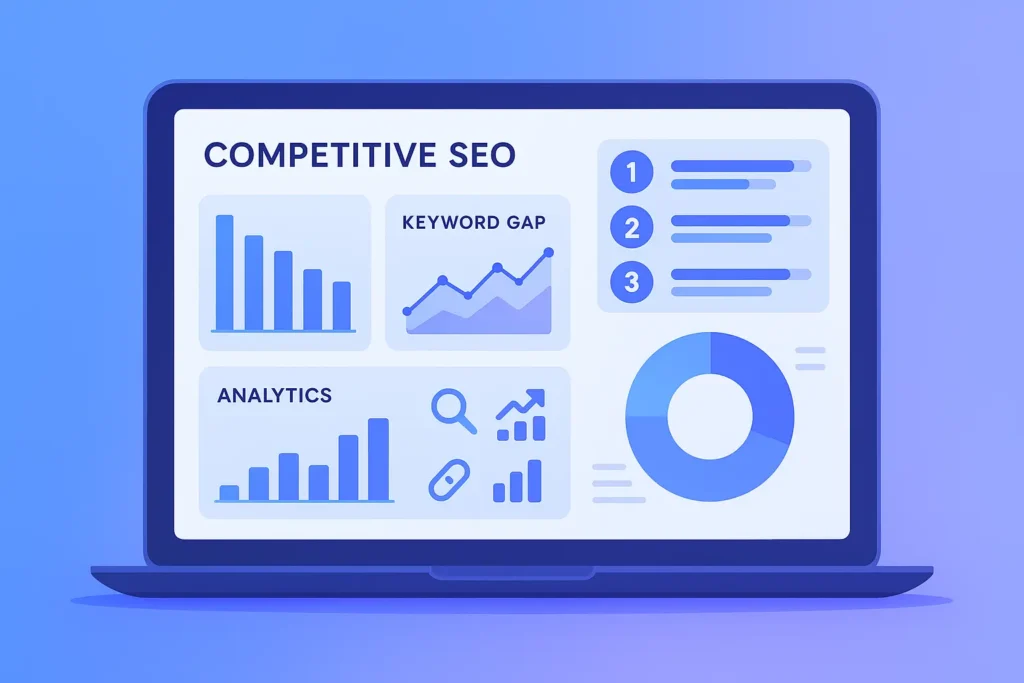Understanding how your website performs against competitors is one of the most effective ways to grow your rankings. Instead of guessing why another site outranks you, a proper comparison reveals real factors such as content depth, keyword strength, technical health, and backlinks. With the right approach, you can uncover opportunities that directly improve visibility and organic traffic.
Below is a clean and focused blog post that keeps only the most important sections and expands them for clarity, depth, and practical use.
Why Competitor Comparison Is a Core Part of SEO
You can’t fully understand your ranking performance unless you study the websites competing for the same keywords. Search engines rank pages based on relevance, authority, and user experience. Competitors who outperform you usually do so because they deliver something stronger in at least one of these areas.
A structured comparison helps answer the essentials:
- Which keywords competitors rank for that you don’t
- How their content fulfills search intent better
- Why their backlinks boost authority
- What technical advantages help their pages load faster or perform smoother
By understanding these factors, you gain a roadmap of what actually needs improvement rather than wasting time on guesswork.
Identify Keyword Gaps and High Value Opportunities
This is the most important and high impact task when analyzing competitors. Keyword gaps show exactly where competitors collect traffic while you miss out. These gaps often include informational queries, commercial intent terms, and long tail keywords that can drive conversions.
What makes keyword gap analysis valuable
- It uncovers topics you should already be ranking for.
- It helps you build supporting pages that improve topical authority.
- It reveals competitor strengths and weaknesses in specific content areas.
To use keyword gaps effectively:
- Identify high intent and moderate difficulty keywords competitors dominate.
- Review the page they use to rank and determine the content format.
- Create content that is deeper, clearer, and better structured.
- Internal link it strategically to strengthen relevance.
Addressing keyword gaps often leads to quick wins because you target terms already proven to perform.
Analyze Content Depth and Intent Alignment
Content is the foundation of search visibility. Competitors who rank higher usually cover topics more thoroughly or align better with what users expect when they search.
What to evaluate in competitor content
- How many sections they include and the order they follow
- Whether they provide real examples, data, or unique angles
- Whether their formatting improves readability
- How well they satisfy both primary and secondary search intent
If their content is more complete, structured, or user friendly, that’s a direct indicator of what your page needs to improve. The goal isn’t to copy them but to outdo them with clarity, depth, and usefulness.
Most ranking improvements come from strengthening existing pages, especially those stuck between positions 11 to 30.
Understand Backlink Strength and Authority Factors
Backlinks are one of the strongest signals that influence rankings. When a competitor ranks above you, backlinks often play a major role.
Important backlink factors to compare include:
- Domain authority and credibility of linking sites
- Anchor text relevance
- Freshness and consistency of new links
- The type of links they attract, such as PR mentions, resource links, or editorial references
If competitors consistently earn links from high quality domains, their authority increases, making it easier for them to outrank even well optimized content.
You don’t need the exact same links, but you do need a strategy inspired by what works for them. This includes outreach, better content assets, or partnerships in your niche.
Evaluate Technical SEO Advantages Competitors May Have
Technical SEO influences how fast, accessible, and easy to crawl your website is. Even if your content is better, a competitor with cleaner technical performance can still outrank you.
Key areas to compare include:
- Page speed and core web vitals
- Mobile responsiveness
- Schema markup usage
- Internal linking structure
- URL clarity
Improving technical issues often results in immediate ranking improvements because you remove friction between your site and search engines.
Turning Competitor Insights Into Real SEO Growth
Once you understand the data, the final step is execution. Focus on actions that directly improve your authority, content depth, and technical performance, such as:
- Creating pages for missing keywords
- Updating existing content to outmatch competitor depth
- Building authority through targeted backlinks
- Enhancing overall technical performance
Consistent competitive analysis keeps you aligned with search trends and ensures you always know where to improve next.
Ready to Compare Your Site and Find Real Ranking Advantages?
If you want to uncover keyword gaps, analyze competitor strengths, and find accurate opportunities to boost rankings, start your comparison with SEOsets.
FAQs
How often should I compare my site against competitors?
At least once every month. Competitor strategies change quickly, and regular checks help you react before rankings drop.
What if my competitors have more backlinks than I can realistically get?
You don’t need the same number. You need higher quality, more relevant links. Even a few strong links can beat many weak ones.
Can keyword gap analysis improve rankings quickly?
Yes, because you target keywords that already drive traffic for competitors. These typically offer faster results than starting from scratch.
Do I need to compare every competitor?
No. Focus on the top 3–5 that consistently appear for your target keywords. These are the ones influencing your visibility.
Will better content alone help me outrank competitors?
Often yes, especially if their content is outdated, thin, or poorly structured. Strong content paired with basic technical optimization can outperform many competitors.


